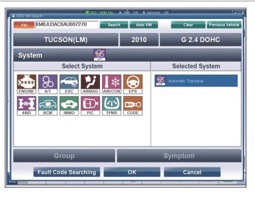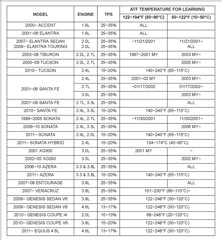Caution: After replacing a transaxle or reprogramming the PCM/TCM, to improve the shift quality condition, follow this procedure to reset and relearn the adaptive learning.
The PCM or TCM contains logic to adjust solenoid duty and line pressure as needed to compensate for normal clutch wear over the life of the transaxle. This bulletin provides the procedures necessary to reset (erase) and “relearn” the PCM/TCM adaptive values.
After the following repairs have been completed, the PCM/TCM adaptive values must be reset in order to provide optimum shift quality:
– Replace automatic transaxle
– Reprogram or exchange a PCM/TCM from another vehicle.
I. Reset PCM/TCM Adaptive Values with GDS:
1. Attach a GDS and select VIN and A/T menu. See Fig. 1.
2. From the main screen, select “Option Treatment.”
3. Select “Resetting Auto TIA values” and follow the screen prompts.
Turn the ignition key off for 10 seconds.
II. Relearn Adaptive Values:
Note: After the adaptive values have been reset (erased), an “adaptive learning” procedure must be completed.
4. Attach a GDS and select VIN and A/T.
5. Select Current Data and “Throttle Position.”
6. Drive the vehicle until the ATF temperature is within the range shown. See chart. 
7. Ask an assistant to monitor the GDS. Accelerate from a stop at the specified IPS specification while the transmission shifts through gears 1-2-3-4-5-6 and decelerate slowly to a stop. Stop for five seconds. Repeat five times.
Note: Hold the accelerator pedal steady during the upshifts.
Caution: Do not exceed legal speed limits.
If additional adaptation is needed, perform the following additional procedures:
8. Perform several sequential downshifts (5-4, 4-3, 3-2 and 2-1) at small-to-moderate throttle openings.
9. Perform several skip shifts (6-4, 5-3, 5-2, 3-1, etc.) at moderate-to-large throttle openings.
10. With the vehicle stopped, move the shift lever from P to N to D and back, stopping three to five seconds in each gear. Repeat five times.
Note: Adaptive learning occurs only within the ATF temperature ranges shown in the chart.
Courtesy of ALLDATA.













